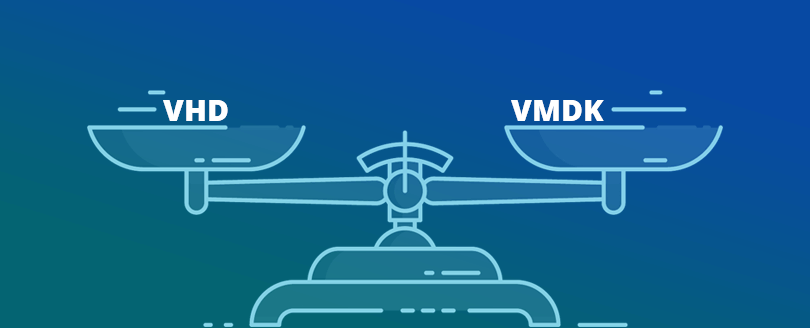Read time 5 minutes
A disk image file is a virtual representation that contains all the data and information found on a physical hard drive. This file, known as a VHD (Virtual Hard Disk), mirrors the original structure of files and folders from the physical drive. These virtual hard disks are versatile, as they can accommodate files from different native systems such as FAT, NTFS, UDFS, and exFAT. Managing VHD files is made easier with the support of the VHD API toolkit.
Disk image files exist on the host system and appear to guest computers as physical hard disks with specific structures. When a guest computer attempts to read from or write to this physical hard disk, the request is redirected to the image file through a virtual environment. Essentially, a virtual disk closely resembles a physical disk and is established with predefined storage parameters at the time of image file creation.
Now, let’s do a detailed study on two major file formats -VHD and VMDK. How they are different? What are the important features? What are their advantages and limitations?
VHD (Virtual Hard Disk) File
A VHD file, short for Virtual Hard Disk file, serves as a replica or storage container for the contents of a physical hard drive, including the files and folders located within its disk volume partitions. Originally, VHD files were primarily used as hard disks for virtual machines. This technology originated with Connectix, who initially developed it for a product called Virtual PC. In 2003, Microsoft acquired Connectix and subsequently rebranded the technology as Microsoft Virtual PC.
- The exclusive usage of VHD file allows you to dwell multiple operating systems on a single machine.
- These types of environments are generally used for testing software on different operating system platforms.
- It is a cost-effective process and does not require partitioning one HDD to multiple volumes or installation of another hard disk.
- You can modify the VM directly from the host server, that includes
- File Recovery
- Full backup of the system
- Control over security and antivirus applications
- Transfer of files from VHD to host system
- Conversion of disk images from virtual to physical and vice-versa
- Managing disk image and patching them.
The benefits of using VHD files are as follows:
- Effective resource utilization: IT organizations can harness these resources to cater to various configurations needed for running and testing diverse sets of applications. Alternatively, they can effortlessly retrieve and set up a VHD from the relevant network location, aligning with their specific requirements.
- Easy Backup and Recovery: You can easily undo and recover the changes done to the data of a VHD/VHDX file that is corrupted and unreadable due to virus infections, deleted or accidentally damaged.
- Supports multiple user accounts: The operating system offers the advantage of multi-user capabilities, enabling the creation of multiple user profiles within a single operating system. Changes made by one user do not impact others, as each user is assigned their own unique instance of the operating system. This separation is achieved by generating distinct VHDs during the initial OS installation process.
- A VHD has a maximum storage limitation of 2 TB i.e. 2040 GB by default.
- The VHD files that reside on NTFS can be mounted
- A size of 512 bytes is internally blocked by VHD
- No resizing is allowed when VHD is live.
The VMDK file format functions as a container for Virtual Hard Disk drives utilized by virtual machines like VMware Workstation and VirtualBox. Essentially, a VMDK serves as a disk image file that VMware developed for their proprietary virtualization products. These files are accessed and can expand in size as they are employed within VMware’s Virtual Disk Manager.
- A VMDK format clones the physical hard disk of a computer system.
- Its replication provides recovery of off-site VM systems that can further protect RAID within SAN storage.
- Simplicity and convenience of use make VMDK outstanding.
- It can be easily migrated or moved to the server using live migration features.
- VMDK is protected with snapshots and CDP (continuous data protection technology).
- You can get effective results and speed by maintaining VM files on a high-performance SAN storage
- You can recreate, and restart affected VMs with the help of VMDK files.
- When data is lost from VMDK disk, it requires a lot of extra efforts and it is almost next to impossible to recover parts of VM like deleted documents of Word or Excel sheets, etc
- The maximum storage size of VMDK is generally 2 TB, but it got enhanced by VMware vSphere 5.5 to 62 TB VMDK in September 2013.
Recommended Solutions to Recover VHD and VMDK File Formats:
While both VHD and VMDK file formats serve virtual environments and come with their respective strengths and limitations, recovering lost or deleted VHD, VHDX, and VMDK files can often be a challenging task. To simplify and expedite the recovery process, we recommend considering third-party solutions like the ones provided by Kernel Data Recovery. Their tools, specifically Kernel for VHD Recovery and Kernel VMDK Recovery Software, have been designed to facilitate the recovery of VHD, VHDX, and VMDK files, making the task more user-friendly and efficient. These tools are worth exploring for anyone facing data recovery needs in virtual environments.
Feel free to mention your queries and doubts in the comments section below.
